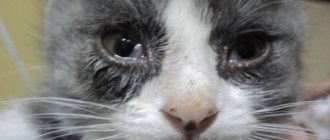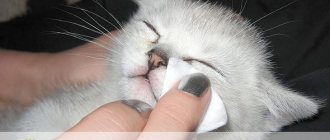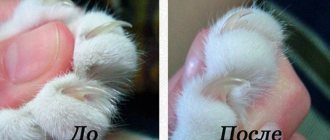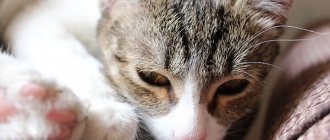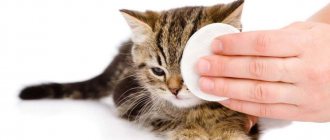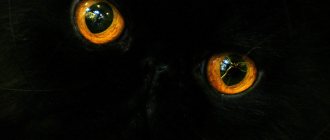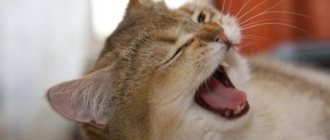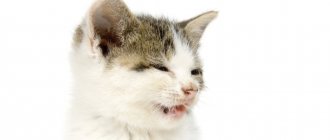When purchasing a pet, a person must approach the issue of caring for it with all responsibility. Every animal needs care, especially if it is a bred breed.
Today it is “fashionable” to have pets of unusual breeds. But it is important to consider that such animals require more careful care.
Today we will tell you how to care for cats of such an interesting breed as the Scottish Fold. Cats do not need any special care. But you need to adhere to several rules that will help the owners make the life of their pet friend calm and problem-free.
Distinctive features
This breed is distinguished by its striking manifestation of sexual dimorphism: males are larger and stockier than females, cats are more graceful and elegant.
Common features:
- almost perfectly round head on a short neck;
- elegant body;
- well developed outstretched paws;
- long straight tail.
The main feature that distinguishes them from the British is their miniature ears, triangular in shape. Because of the crease, they seem to be bent down and pressed against the skull.
International associations allow all colors - from white to tortoiseshell, but there are exceptions: lavender, chocolate and colorpoint.
Bathing
Scottish cats do not require much grooming due to their short coat, but they do need bathing, especially light-colored cats. There is no need to bathe them often, since there is a special greasy lubricant on the skin under the fur. Long-haired - once a month, short-haired less often - once every 2 months.
It is not recommended to bathe a kitten in the first months unless absolutely necessary (it is permissible to wash the baby if necessary). But when he grows up and gets stronger, then start accustoming him to this procedure (in a basin) and in the future you will not have problems with bathing.
It is difficult to cope with a large cat, so someone's help will be required. Cats are afraid of the sound of water. Therefore, warm water must be poured into a basin, sink or bathtub in advance. There should be a little water in the bath - and the cat is not so scared and it is convenient for you to soap it. Then water from a ladle or a weak shower.
It’s even better to put it in the sink and carefully water the cat with warm water, calmly, gently holding it, lather it with shampoo, avoiding the face and ears, and then rinse thoroughly, since after bathing the cat will definitely lick its fur and the remaining shampoo will get into its mouth. You need to be careful not to let water get into your ears and mouth.
Then wrap it in a towel and blot the water. Keep windows closed to prevent drafts. When the coat is almost dry, comb it.
For short-haired cats that do not like to be washed, there are dry shampoos. This is a salvation if the cat is simply terrified of water. This powdered shampoo removes dirt and excess oil from the animal's fur. Some time after application, it is combed off the fur along with the dirt. A high-quality dry shampoo cleans almost as effectively as liquid shampoo and makes combing the coat just as easy.
There are also tinted shampoos for cats of different colors, for short-haired and long-haired. But they are used before exhibitions.
You cannot wash cats with soap.
Do not wash with “human” shampoos either.
Do not bathe a sick animal!
If the cat does not want to bathe - it scratches, breaks out, you can sew it a special bag with ties from fabric that allows water to pass through. Pour shampoo inside and place the cat in this bag, tying it around the neck. Then immerse in warm water and wash.
MisterCat warns: advantages and disadvantages
The breed has various advantages and disadvantages.
| pros | Minuses |
| Sweet beautiful face. | Greed. |
| Friendliness. | Indiscriminate eating. |
| High intelligence. | Prohibition on mixing with fold-eared and British cats. |
| Wide range of colors. | Selfishness. |
| Good health and long life. | Stubborn character. |
| Love for cleanliness. | Fear of moving. |
Relationship with the toilet
If you take a kitten from a breeder, then the baby, as a rule, already knows that there is a special place for the toilet. When he appears in the house, you should immediately show him the tray, and the smart animal will not cause you problems, leaving puddles in the wrong places
Pay attention to the toilet filler. It is better if at first it is the same as in the previous house
The Scots prefer silica gel, which they love to dig for, enjoying the rustling sounds. In addition, it perfectly eliminates all odors. You can also choose sawdust pellets, but they require more frequent replacement.
If the baby is not yet familiar with the cat litter box, you need to immediately start raising the kitten until he gets used to relieving himself in places convenient for him. You should immediately explain to your pet that there is a special corner for the toilet.
A place for the tray must be chosen that is easily accessible, but quite secluded. Many cats like to do their business without attracting too much attention to themselves. A bathroom, toilet, or closet is best suited for this purpose. Just remember to always leave the door slightly open. You can choose a corner in the corridor.
If you categorically refuse to use the tray, changing the filler or its location often helps.
Temperament
The Scots are moderately active, preferring sleep to aimless running around. This does not prevent them from being playful and active when necessary. They love various games with toys, and with proper training they quickly learn commands.
Dependent on human attention. They quickly become attached to the family. They don’t choose a “favorite” - they love every family member equally. They cannot stand being alone for long periods of time, so people without a family and with a job that requires constant absence should not get a pet.
This does not mean that the pet is annoyingly intrusive; on the contrary, their high level of intelligence helps them understand when they are in the way. They are not loud, their voice is quiet and pleasant.
The only thing that throws a Scottish cat out of balance is moving or a new place. In this case, the owner should be nearby and help him adapt correctly.
Sociable pets react calmly to small children and other pets.
Choosing the gender of the kitten
When thinking about who is more useful on the farm, a cat or a female cat, you should not blindly trust the description of the breed’s character, as well as theses about the greater affection of females and the unsociability of males. In practice, everything may turn out differently, since the disposition of the future pet depends little on its gender, and sometimes even contradicts the breed characteristics.
That is why, when deciding on the gender of the Scottish Fold, proceed from a specific goal. If the breeder's laurels attract you, buy a breed or show-class female. You can, of course, take a breeding cat, but keep in mind that the requirements for males are much higher, and they are somewhat more difficult to maintain.
It is much easier for those who choose a Scottish Fold solely to enliven family leisure time. In this case, as a rule, the choice falls on the boy. Firstly, castrating an animal is somewhat easier than sterilizing it. Secondly, adult cats (due to their size) look more respectable and more prestigious than female cats.
Nutrition
The main disadvantage of the breed is greed and indiscriminate eating, which leads to serious illnesses. Experienced breeders advise creating a diet.
Before purchasing, find out how feeding went in the first house. The transition from the old regime should be smooth so that the baby’s fragile body is not damaged.
The first additions are soft canned or bagged food. After the fourth month, premium dry food is added, which contains enough protein, vitamins and essential taurine.
The main thing is to avoid excess calcium in the kittens’ diet so that their ears don’t stand up.
As a reward or just a treat, occasionally give meat or fish and vegetables.
Kittens should not eat:
- homemade food;
- sausages;
- sweets;
- bird bones.
How to raise a newborn kitten
The Scots are good parents. Attentive, caring and patient. How long do pregnant Scottish cats walk? Pregnancy lasts 60-65 days, like all representatives of domestic cats.
But it happens that a mother cat refuses her kittens. Raising a newborn kitten without a cat is not an easy task. It is quite difficult to organize proper care for a Scottish kitten, because the baby requires a lot of time, effort and money.
Newborn Scottish kittens
Until 1.5 months, all kittens eat mother's milk. The best replacement would be special milk powder from Royal Canin and Beafar. From 1.5 months of age, you can slowly switch kittens to soft pates from Royal Canin.
Defecation and urination
The mother helps newborn kittens go to the toilet by licking the underbelly. In conditions without a cat, the mother's tongue can be replaced with a soft, wet cloth. In order for the baby to go to the toilet, you need to gently rub his genitals and anus until discharge appears. If this is not done, the kitten may die.
If an accident befell the mother of the kittens or the babies were found on the street, it is better to place them with another cat that has recently lambed. As a rule, cats calmly raise and educate other people's babies. In this regard, the Scots are excellent parents to both their own and adopted children.
The life expectancy of Scottish cats at home is 15-20 years. Spayed and neutered animals live longer and happier lives. What kind of life a cat has to live depends only on its owners
Surrounded by care and attention, she will give her people many pleasant years
Upbringing
From the first days, it is important to teach your baby a routine in the house, communicate with him, and show him who is in charge in the house. An ill-mannered and uncommunicative creature will bring many problems in the future. Smart pets are prone to manipulation and whims if they do not see authority in a person.
Before buying, you need to come up with a name and say it more often so that he gets used to it faster.
You should not resort to physical punishment; the best method of education is a decisive “no” and patience. The most important thing is to show that the cat should not climb onto tables, beds and all forbidden places in the house.
Aggression and whims are condemned. Damage to things must not be allowed.
Prevention of lacrimation
Special cleaning products from veterinary pharmacies will help cope with the washing procedure; you can also use herbal decoctions and furatsilin solution.
Store household chemicals outside your pet’s habitat, do not spray aerosols on the mucous membrane, and take the cat out of the room if you are cleaning.
Often, owners who have a Scottish Fold cat and her eyes are watery cannot figure out what to do in this case. Particular attention should be paid to the prevention of lacrimation by adhering to simple hygiene rules.
Taking care of your Scottish kitten's eyesight will help avoid problems in the future and prolong the joy of communicating with your beloved pet.
Did you like the article?
Care
Scottish Folds are not picky and do not require any maintenance skills.
Eyes
Month-old kittens are prone to eye infections. First of all, you need to show them to the doctor. Standard treatment is to periodically wipe with a cotton swab soaked in chamomile infusion or medicine.
Ears
The weak point of all such cats. Cleaning is carried out at least once a week. It is better to replace cotton swabs with tampons with a special liquid. It is important to be careful so that your little pet gets used to the procedure and does not experience fear.
A typical disease - ear mites - manifests itself in the appearance of a brown crust in the ear. At the first symptoms, you need to see a veterinarian as soon as possible.
Wool
The fur does not require special care. During shedding, it is enough to brush no more than once a week. Increased attention is paid to a pet that walks along the street in the spring-autumn period - there is a high probability of acquiring a company of ticks.
Water treatments
Professional breeders offer the following method of accustoming to water: at first you need to wrap the baby in a wet towel, then reward him with a treat. Thus, he will understand that water is not scary.
Before bathing in the bath, you need to protect your ears from moisture getting into them by plugging them with cotton pads. The water temperature should be warm and as comfortable as possible for the pet. To do this, measure the water with your elbow. Human shampoo will cause skin problems.
It is necessary to use special tools designed taking into account her needs.
Claws
It is recommended to purchase specialized nippers: they do not separate the claw, but immediately cut off the excess. It is extremely important not to touch the vessels inside, as this is painful for the pet.
Health and vaccination
Peculiarities of breeding have caused the appearance of several hereditary diseases:
- Glaucoma, cataract, entropion. Also read the article about eye diseases in cats.
- Demodicosis, eczema, allergies.
- Congenital deafness, tendency to otitis media.
Even if the owner does not plan to let the pet out of the apartment, vaccination is mandatory, since infections can be brought into the house on shoes or clothes. The first vaccination is given at the age of three months; you can learn about further procedures from your veterinarian.
Causes of lacrimation
Morning tears
The lacrimation observed in cats of Scottish and British breeds at an early age is directly related to breed characteristics. The special shape of the Scottish kittens' skull, shortened tear troughs and narrowing of the tear duct causes a slight release of moisture, especially in the morning.
Discharge from the eyes of Scottish Folds is normal, because the structural features of the nasolacrimal duct do not allow it to remove fluid when the eyes are closed. After waking up, a small amount of clear tear fluid is released, which is associated with morning tearing.
Kittens' eyes water more than adults; this goes away with age and should not cause concern only if the tear fluid is transparent and does not have any extraneous shades - yellow, brown, green, otherwise there is a good reason to consult a veterinarian.
Age-related tearing
If your Scottish cat is over 10 years old, pay special attention to the condition of his eyes. Tearing at this age is an obvious sign of cataracts and clouding of the lens, which then causes complete blindness of the animal. The lens becomes white and cloudy, and this disease cannot be cured.
Increased intraocular pressure can also cause fluid to leak, and cats are prescribed medications.
The progression of eye diseases is often associated with skipping vaccinations, while Scottish cats begin to get sick, but they do not have immunity. The development of the disease is also reflected in the eyes, and this process will be irreversible; the only way out is not to skip vaccination periods.
Diseases
- Allergic reactions. Determining the allergen is quite difficult; to do this, you need to exclude contact with hazardous products and substances with which the cat is in close contact, including litter for the tray and powder for washing it, as well as dust. Additional symptoms will be a constant runny nose, itching, nausea and vomiting, increased shedding, weight loss, and an unpleasant odor from the animal’s mouth.
- Fungal infection. Infection with fungal pathogens, viruses and bacteria can only be diagnosed by a doctor. Timely vaccination and regular visits to the veterinarian can prevent the development of such a problem.
- Infectious keratitis. Inflammation of the cornea is very painful, causing itching and severe pain along with photophobia and obvious manifestations of anxiety in the animal. Characterized by white and yellow discharge from the eyes. If left untreated, the cat will develop a cataract and then the lens may fall out, leading to complete blindness.
- Retinal detachment. The disease in a cat can be diagnosed by dilated pupils; it requires emergency intervention from a doctor. The development of retinal detachment is provoked by eye injuries, congenital anomalies and inflammatory processes associated with fluid accumulation in the subretinal area.
- Cataract. Accompanied by clouding of the lens, which becomes smoky or whitish and then does not recover. The older the Scots cat, the higher the risk.
- Inflammation of the cornea (keratitis). Leads to serious consequences, including complete blindness as a result of the formation of a film covering the surface of the eyelid.
- Turn of the century. British and Scottish cat breeds are prone to this disease due to the specific structure of the eye, as a result of which the ingress of eyelashes and fur causes irritation of the mucous membrane and lacrimation.
Other reasons
If your Scottish Fold cat's eyes often water, it could be due to the following:
- Contamination of the eye area. The immunity of two to three week old pets is not yet able to cope with environmental irritants.
- Blocked tear ducts that can only be identified by a veterinarian.
- Colds and mechanical damage. The ingress of dust, litter and other types of pollution causes a protective reaction in the form of lacrimation in adult Scottish cats. A similar reaction occurs as a result of injury in a fight or unsuccessful play. Brown discharge indicates infection.
- Diseases of worms and the presence of other parasites in the body.
- Late vaccination, as a result of which the kitten’s immunity is reduced.
Features of the diet and nutrition of Scottish kittens
Nutrition and feeding of fold-eared babies is a separate issue, but there are no problems with Scottish Folds here either. They love to eat delicious food. They cannot be called capricious and picky. Whatever is offered to them will definitely be eaten. Meanwhile, feeding should only be done with balanced ready-made food. And if very small pets cannot master it at first, then there should be no problems with an older cat
When moving from soft pate to dry food, it is important to provide the kitten with a sufficient amount of protein and a minimum of carbohydrate foods. At the same time, the finished feed is enriched with vitamins and all the microelements necessary for the animal.
Ideally, the most correct feeding involves alternating canned food and dry food. In addition, it is worth knowing that:
- Water must be constantly available to the animal. There is no need to limit his fluid intake.
- Kittens should not drink cow's milk as this product causes stomach upset.
- It is also undesirable to feed a cat from the master’s common table, since the pet’s digestive system is not adapted to preservatives, smoked meats, sweets and everything else that a person eats.
Proper care and healthy food for a kitten are the key to its further full existence and development.
Basic information about Scottish Fold kittens
An adult Scottish Fold is always a cat with ears pressed to the head, but kittens are always born with straight ear cartilages. In purebred individuals, the ears droop only at 3 months. That is, if you buy a kitten, then the most important proof of belonging to the breed will manifest itself just at the moment the pet is transferred to you.
By nature, Scottish Fold kittens are very quiet, one might even say that they are shy cat children. Yes, the baby won’t mind playing with you at all, but he won’t run around the house and hang on the curtains. The kitten is more likely to nestle under your side than to defiantly bring toys to your feet and demand attention.
In matters of health, a huge role is played by a correctly constructed pedigree and the absence of a large baggage of hereditary diseases in the family branch. The most dangerous thing about ill-conceived crossbreeding is hereditary diseases of the cartilage and spine, which, alas, are not uncommon for the fold-eared breed.
INTERESTING: the breed of Scottish Fold cats is famous for its silence. Even kittens do not meow, but make sounds very similar to creaking from the inside.
Among the unusual habits of lop-eared kittens, they love to sleep on their backs and sit like a meerkat on their hind legs. This is again due to the large load on the weak spine of the breed - interesting pressed ear cartilage at the genetic level is always associated with a weakened spine.
In matters of intelligence, Scottish Fold kittens are able to amaze their owner. Learning household rules and basic commands for a fold-eared kitten is not difficult; the main thing is not to delay the learning process, but to start it as soon as the baby appears in his new home.
The kitten immediately treats all family members equally, only closer to adulthood the cat decides with whom it is more comfortable to be around, although the breed does not show special attention. This has a big advantage both in terms of cuddling the cat and in the execution of commands from the whole family, and not just from the chosen “owner”.
IMPORTANT: the biggest stress for the breed is traveling or moving. The kitten may be apathetic and sad for the first week, so if you get this breed, be prepared not to leave the animal alone for more than 2 days, and also not to carry it with you everywhere to the dacha or on vacation. It is better for the breed to stay at home with a familiar “nanny” than to go to a new place with everyone else.
Manifestations of pathology
Before treatment, the animal’s condition should be assessed, so pay attention to the duration and nature of eye discharge, the presence or absence of other symptoms.
Signs may be as follows:
profuse lacrimation;- swelling around the eyes;
- brown, green and yellow discharge;
- impurities of pus in the discharge.
A Scot with pathology may constantly rub his eyes.
In some cases, symptoms include:
- hyperthermia;
- copious nasal discharge;
- drowsiness;
- changes in habitual behavior;
- apathy;
- pet anxiety;
- cough.
If symptoms appear that are not normal, you should consult your veterinarian.
